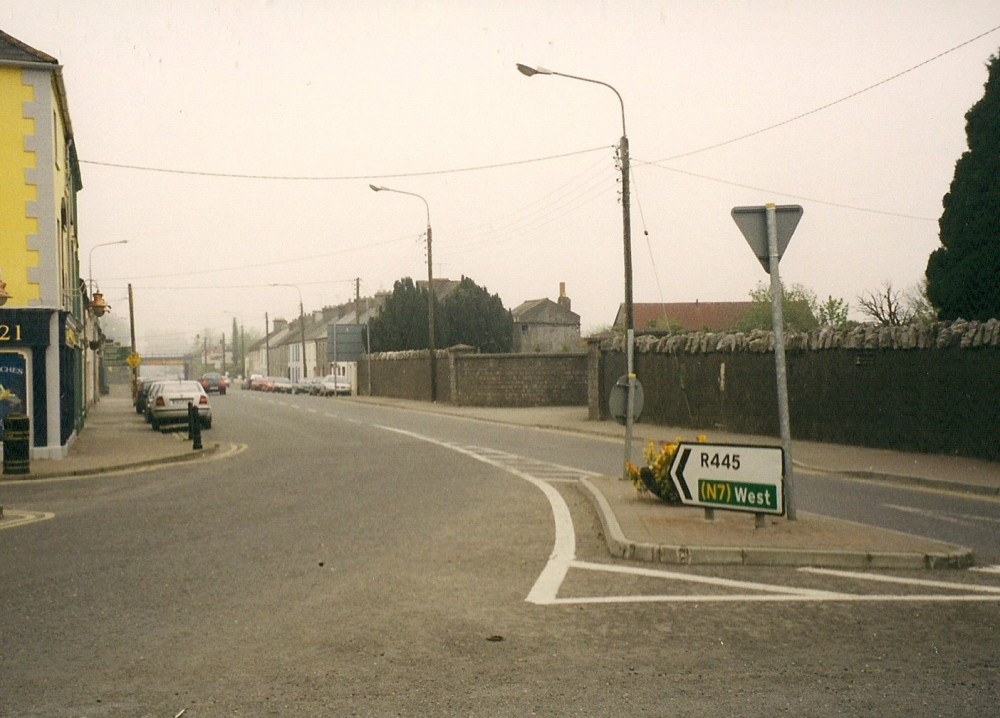Looking into Grattan Street which, in the 1840's, was known as Coburg Row and, later in the century, as both Coburg Street
and Quality Row. Coburg is a common placename in many countries and there is a street of
that name in Cork City, but I have been unable to find any definitive explanation of its provenance here. One distant possibility
is that it was named after the town
in Bavaria near which Prince Albert, husband of Queen Victoria, was born in 1819. Quality Row speaks for itself.
The street appears under both names on the 1901 Census Form but, ten years later, there is no mention of the elusive Coburg.
The name Grattan Street does not appear in the 1911 Census either. This is interesting because, in local cemetery records, the name was in
common use since 1906 (the 160th anniversary of Henry Grattan's birth). I wonder whether the use of either name varied depending
on the political affiliation of the writer? A present-day resident recalled hearing that one side
was known as Coburg Street and the other Quality Row, but I have been unable to confirm this.
Henry Grattan was leader of the Irish parliament (known as Grattan's Parliament) in the late 18th
century. The story goes that he wished to be buried on his estate at Moyanna,
Vicarstown, but was, however, laid to rest in Westminster Abbey.
Between the churchyard and the red-roofed building on the right (a store belonging to Johnny Daly's long-gone shop),
obscured by fifty years of vegetation, stands an almost forgotten part of
the social history of the town. For many years, amid flurries of feathers and all sorts of banter, it was in a shed here that local
people were employed in the 'plucking ring'.
It was here you would find the chokers, roughers and pluckers.
Only the middle one of those three needs any explanation: they dealt with the larger, rougher feathers before passing the bird on
to the pluckers for the finer work. More often than not, the pluckers were women.
Someone told me that, in the old days, an allowance of one bottle of stout per day was placed
beside each chair and, to prolong their pleasure, the pluckers drank it through a straw. This evokes a striking image,
but one totally contradicted by another man
whose mother was once part of the ring.
When times were hard, the pluckers used to take bogawns1 from the
hens and, to quote exactly what I was told, "if you had two of them for your breakfast you'd be made up".
A billhead from 1924 reads: John Egan & Sons. Wholesale Poulterers and Egg Merchants.2
[John Egan was the great-grandfather of his namesake who, in recent memory, had the bar and restaurant in 24-25 Lower Main Street.
A site subsequently occupied by O'Loughlin's Blue Door Bar & Restaurant (2015) and, from 2018, Lilly's Bar & Kitchen. The latter closed down in February 2023].
Next door was the - now demolished - home of Kathleen 'Thrush' Egan, famous for foretelling the future by means of playing cards. Which reminds me of
the clairvoyant who was a candidate in a local County Council election. On her way in to vote, a local wag called
after her "Well - , were ya elected?"
1
Eggs before the shell is formed. In Irish, bogán, derived from bog the word for 'soft'.
The same word, incidentally, was sometimes used to describe a delicate or effeminate person.
2
Local people used to refer to dealers in eggs and poultry as 'higglers', a word that encompassed both
'haggler' and the archaic term 'eggler'. John Durbeyfield, father of the eponymous heroine in
Thomas Hardy’s Tess of the D’Urbervilles was, for instance, a higgler, but nowadays, with the exception of the West Indies,
especially Jamaica, the word seems to have disappeared everywhere else.



HOMEPAGE